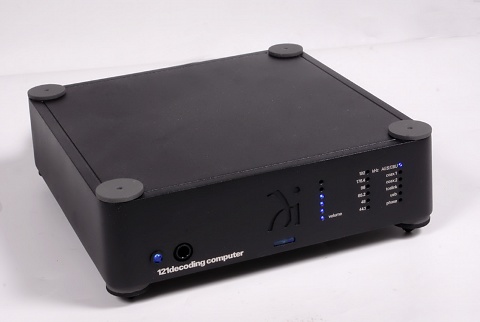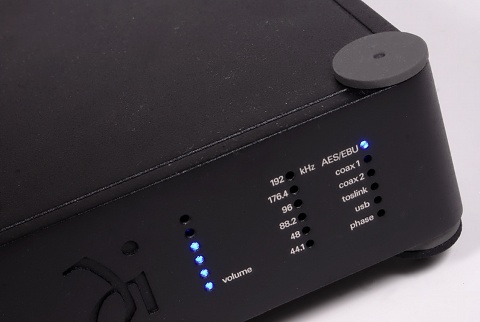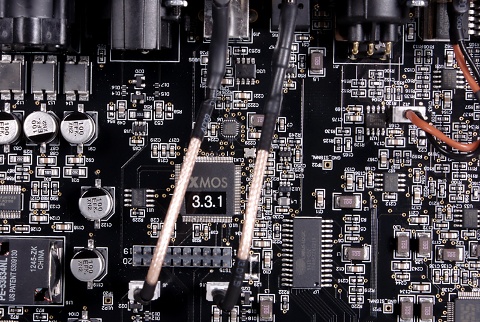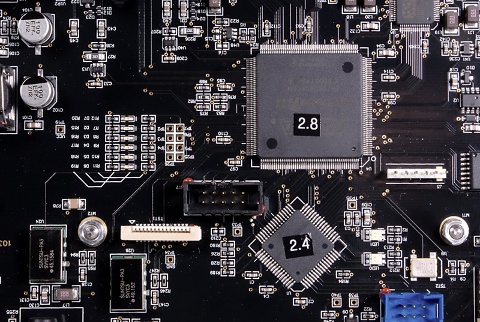about Audio, High Fidelity
& Home Entertainment technologies
pid: 607-2025/10/01 (v1.2)
Privacy Policy

It is clear that the chassis of the 121 is based on the Mini series, an interesting and practical concept which in recent years has become Wadia's trademark. The 121 is a small volume device, finished in classic gray textured paint. Four rubber cones are used for support. The front panel includes a number LEDs which inform the user about the selected input, the sample rate at which this input is locked and the level of the analog output. Interesting design choice here is the absence of any switch, including a power on/off. The user has access to any function only through a well-designed remote control. In practical terms, this is a logical choice. But insecure as we are, we would prefer to have some option when the battery runs out, the control is misplaced or as long as its repair/replacement will take …
The chassis design is based in those of the Mini series. It gives the 121 an interesting and distinctive appearance and allows for easy placement through four elastic cones.
The connection options are typically good. There are two coaxial inputs (one with a 75 Ohm BNC), a Toslink, an AES/EBU and a USB port, to connect with digital sources. Connection to the amplifier is via single ended/balanced analog outputs. The 121 supports sample rates up to 24bit/192kHz for all inputs and the USB port requires, as usual, a driver when used in Windows OS, if the user wants to stream with sample rates above 96kHz. The analog signal is presented simultaneously on both output pairs, which are muted when a headphone jack is inserted. The 121 stores the level setting that the user has selected separately for headphones and the line output. Wadia has chosen not to include analog inputs to 121, probably in an effort to keep costs low, which may limit the ability of the device to be used as the only preamp in a system. The current version is not able to stream DSD.
A series of LEDs informs the user about the level, the sample rate of the incoming signal and the selected input.
The device has no switch on the front panel. All functions are performed by using the remote. Also, Wadia does not use an on/off switch.
Inside the device resides a dense PCB based entirely on SMD, something expected of course, given its small size and processing capabilities. An XMOS chip is used for the USB stream management (streaming is asynchronous), while for the standard digital inputs the interface is based on a Cirrus Logic 8416. An FPGA from Altera presumably runs the digital signal processing and it is here that Wadia uses the advantage of their experience. The 121 incorporates DigiMaster in its fourth version, a Wadia algorithm that offers 4x resampling and a polynomial of the 12th degree approach to calculate the four intermediate samples. According to Wadia, this process of interpolation leaves intact the original samples. When it comes to jitter control, the 121 uses two different approaches. In the case of streaming via USB, a technique which the company calls ClockLink is used. ClockLink is based on asynchronous streaming, with the key feature that the oscillator circuit is located at a minimum distance from the DAC chip. When the standard digital inputs are in use, a different, more complex, approach, ClockLock is engaged. In this case the DAC clock is variable and it is synchronized with the incoming signal (a technique reminiscent broadly PLL but implemented in the FPGA device, the Wadia does not give many details). Signal level adjustment is performed in the digital domain. The 121 provides 120 steps of 0.5dB and, according to the company, this is sufficient for attenuation of the digital signal by 48dB without negative effects in resolution terms. In order not to need more than 48dB of attenuation, the user can select, through the remote control, three different full scale output settings (1, 2, and 4Vrms) to accommodate the amplifier input stage that follows the DAC. These settings are made in the analog domain with very low tolerance resistors (0.1 %).
The unit offers four standard digital inputs and a USB port. Analog output is offered in single ended and balanced version. There is no analog input, therefore the 121 cannot substitute for your analog preamplifier.
The DAC chip used is the ESS ES9018 whose eight channels are distributed, four per stereo channel in a balanced topology. The i/v converter, that follows is based on a circuit which is known as “current conveyor” and is considered by many as a very good approach that uses no feedback loop. Wadia developed their own version, named the SwiftCurrent (SC-5, in the case of 121), but they are not giving any interesting details about it. The remaining analog stage is based on low-noise operational amplifiers, while the headphone amplifier is implemented around an LME49600 chip from National. To main power supply is external, but the device itself includes multiple local regulators per circuit part, with basic regulation done through two LM3100 in a dc-dc converter role
The digital interface is an 8416 from Cirrus (left), while the converter chip comes from ESS (ES9018, bottom right). Above the DAC resides the analog output stage and the headphone amp as well.
In the upper part of the photo shows one section of the power supply. There is, also, an external power pack.









